Siddharth Patki
PARTNR: A Benchmark for Planning and Reasoning in Embodied Multi-agent Tasks
Oct 31, 2024



Abstract:We present a benchmark for Planning And Reasoning Tasks in humaN-Robot collaboration (PARTNR) designed to study human-robot coordination in household activities. PARTNR tasks exhibit characteristics of everyday tasks, such as spatial, temporal, and heterogeneous agent capability constraints. We employ a semi-automated task generation pipeline using Large Language Models (LLMs), incorporating simulation in the loop for grounding and verification. PARTNR stands as the largest benchmark of its kind, comprising 100,000 natural language tasks, spanning 60 houses and 5,819 unique objects. We analyze state-of-the-art LLMs on PARTNR tasks, across the axes of planning, perception and skill execution. The analysis reveals significant limitations in SoTA models, such as poor coordination and failures in task tracking and recovery from errors. When LLMs are paired with real humans, they require 1.5x as many steps as two humans collaborating and 1.1x more steps than a single human, underscoring the potential for improvement in these models. We further show that fine-tuning smaller LLMs with planning data can achieve performance on par with models 9 times larger, while being 8.6x faster at inference. Overall, PARTNR highlights significant challenges facing collaborative embodied agents and aims to drive research in this direction.
Resolving Ambiguity via Dialogue to Correct Unsynthesizable Controllers for Free-Flying Robots
Apr 11, 2023Abstract:In situations such as habitat construction, station inspection, or cooperative exploration, incorrect assumptions about the environment or task across the team could lead to mission failure. Thus it is important to resolve any ambiguity about the mission between teammates before embarking on a commanded task. The safeguards guaranteed by formal methods can be used to synthesize correct-by-construction reactive controllers for a robot using Linear Temporal Logic. If a robot fails to synthesize a controller given an instruction, it is clear that there exists a logical inconsistency in the environmental assumptions and/or described interactions. These specifications however are typically crafted in a language unique to the verification framework, requiring the human collaborator to be fluent in the software tool used to construct it. Furthermore, if the controller fails to synthesize, it may prove difficult to easily repair the specification. Language is a natural medium to generate these specifications using modern symbol grounding techniques. Using language empowers non-expert humans to describe tasks to robot teammates while retaining the benefits of formal verification. Additionally, dialogue could be used to inform robots about the environment and/or resolve any ambiguities before mission execution. This paper introduces an architecture for natural language interaction using a symbolic representation that informs the construction of a specification in Linear Temporal Logic. The novel aspect of this approach is that it provides a mechanism for resolving synthesis failure by hypothesizing corrections to the specification that are verified through human-robot dialogue. Experiments involving the proposed architecture are demonstrated using a simulation of an Astrobee robot navigating in the International Space Station.
Language Understanding for Field and Service Robots in a Priori Unknown Environments
May 21, 2021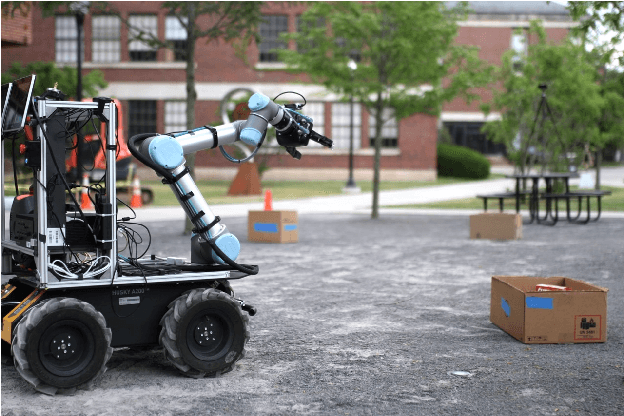

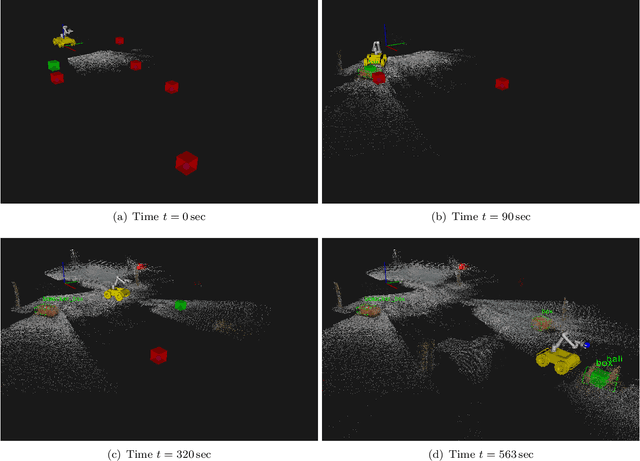

Abstract:Contemporary approaches to perception, planning, estimation, and control have allowed robots to operate robustly as our remote surrogates in uncertain, unstructured environments. There is now an opportunity for robots to operate not only in isolation, but also with and alongside humans in our complex environments. Natural language provides an efficient and flexible medium through which humans can communicate with collaborative robots. Through significant progress in statistical methods for natural language understanding, robots are now able to interpret a diverse array of free-form navigation, manipulation, and mobile manipulation commands. However, most contemporary approaches require a detailed prior spatial-semantic map of the robot's environment that models the space of possible referents of the utterance. Consequently, these methods fail when robots are deployed in new, previously unknown, or partially observed environments, particularly when mental models of the environment differ between the human operator and the robot. This paper provides a comprehensive description of a novel learning framework that allows field and service robots to interpret and correctly execute natural language instructions in a priori unknown, unstructured environments. Integral to our approach is its use of language as a "sensor" -- inferring spatial, topological, and semantic information implicit in natural language utterances and then exploiting this information to learn a distribution over a latent environment model. We incorporate this distribution in a probabilistic language grounding model and infer a distribution over a symbolic representation of the robot's action space. We use imitation learning to identify a belief space policy that reasons over the environment and behavior distributions. We evaluate our framework through a variety of different navigation and mobile manipulation experiments.
Language-guided Semantic Mapping and Mobile Manipulation in Partially Observable Environments
Oct 22, 2019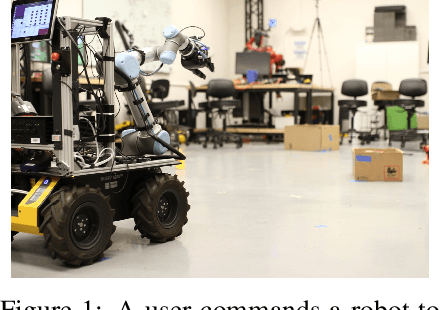


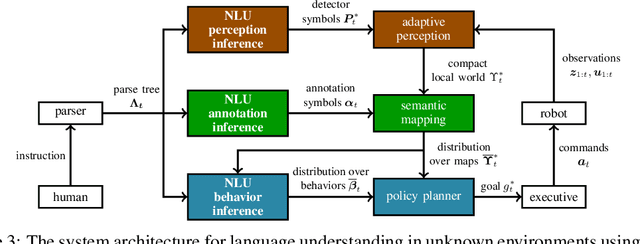
Abstract:Recent advances in data-driven models for grounded language understanding have enabled robots to interpret increasingly complex instructions. Two fundamental limitations of these methods are that most require a full model of the environment to be known a priori, and they attempt to reason over a world representation that is flat and unnecessarily detailed, which limits scalability. Recent semantic mapping methods address partial observability by exploiting language as a sensor to infer a distribution over topological, metric and semantic properties of the environment. However, maintaining a distribution over highly detailed maps that can support grounding of diverse instructions is computationally expensive and hinders real-time human-robot collaboration. We propose a novel framework that learns to adapt perception according to the task in order to maintain compact distributions over semantic maps. Experiments with a mobile manipulator demonstrate more efficient instruction following in a priori unknown environments.
Language-guided Adaptive Perception with Hierarchical Symbolic Representations for Mobile Manipulators
Sep 21, 2019



Abstract:Language is an effective medium for bi-directional communication in human-robot teams. To infer the meaning of many instructions, robots need to construct a model of their surroundings that describe the spatial, semantic, and metric properties of objects from observations and prior information about the environment. Recent algorithms condition the expression of object detectors in a robot's perception pipeline on language to generate a minimal representation of the environment necessary to efficiently determine the meaning of the instruction. We expand on this work by introducing the ability to express hierarchies between detectors. This assists in the development of environment models suitable for more sophisticated tasks that may require modeling of kinematics, dynamics, and/or affordances between objects. To achieve this, a novel extension of symbolic representations for language-guided adaptive perception is proposed that reasons over single-layer object detector hierarchies. Differences in perception performance and environment representations between adaptive perception and a suitable exhaustive baseline are explored through physical experiments on a mobile manipulator.
Inferring Compact Representations for Efficient Natural Language Understanding of Robot Instructions
Mar 21, 2019
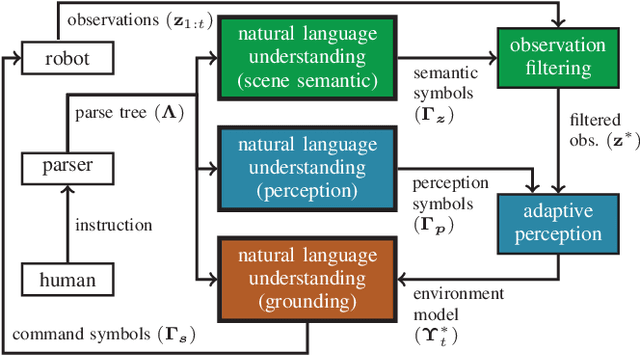


Abstract:The speed and accuracy with which robots are able to interpret natural language is fundamental to realizing effective human-robot interaction. A great deal of attention has been paid to developing models and approximate inference algorithms that improve the efficiency of language understanding. However, existing methods still attempt to reason over a representation of the environment that is flat and unnecessarily detailed, which limits scalability. An open problem is then to develop methods capable of producing the most compact environment model sufficient for accurate and efficient natural language understanding. We propose a model that leverages environment-related information encoded within instructions to identify the subset of observations and perceptual classifiers necessary to perceive a succinct, instruction-specific environment representation. The framework uses three probabilistic graphical models trained from a corpus of annotated instructions to infer salient scene semantics, perceptual classifiers, and grounded symbols. Experimental results on two robots operating in different environments demonstrate that by exploiting the content and the structure of the instructions, our method learns compact environment representations that significantly improve the efficiency of natural language symbol grounding.
Robot-Initiated Specification Repair through Grounded Language Interaction
Oct 03, 2017



Abstract:Robots are required to execute increasingly complex instructions in dynamic environments, which can lead to a disconnect between the user's intent and the robot's representation of the instructions. In this paper we present a natural language instruction grounding framework which uses formal synthesis to enable the robot to identify necessary environment assumptions for the task to be successful. These assumptions are then expressed via natural language questions referencing objects in the environment. The user is prompted to confirm or reject the assumption. We demonstrate our approach on two tabletop pick-and-place tasks.
 Add to Chrome
Add to Chrome Add to Firefox
Add to Firefox Add to Edge
Add to Edge